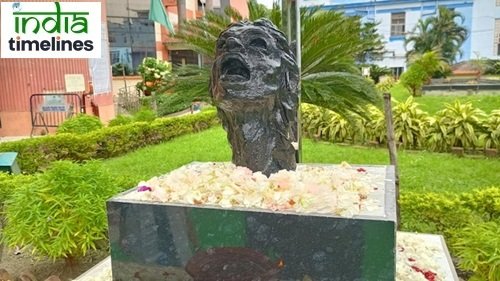
In a poignant yet controversial gesture, a statue commemorating a young rape and murder victim was recently unveiled at RG Kar Medical College and Hospital in Kolkata. While intended to honor the memory of the victim and raise awareness about violence against women, the statue has ignited a public debate, sparking tensions and deepening conversations about justice, representation, and the politics surrounding victim memorials in India.
The incident that led to the creation of this memorial dates back several years, but it remains etched in the collective memory of Kolkata and the wider Indian public. The crime in question, which involved the brutal rape and murder of a young woman, shook the city to its core and highlighted the alarming prevalence of violence against women in India. In unveiling this statue, organizers hoped to immortalize her legacy and catalyze discussions around women’s safety and gender-based violence. However, the public reaction has been mixed, with some praising the effort as a much-needed reminder of ongoing struggles, while others have criticized it for being politically motivated or even inappropriate.
The Incident That Shook Kolkata
The story of the victim, whose life was tragically cut short, began like any ordinary day. She was an aspiring young woman, full of dreams and ambitions, living her life in Kolkata. One evening, she was kidnapped, brutally raped, and subsequently murdered, her body found in a state that horrified the entire city. The crime was not an isolated case in a country where violence against women is a deeply ingrained societal issue, but it resonated across India due to its sheer brutality.
The case, widely covered by both national and international media, led to an outcry for justice. Protests demanding swift legal action and greater protections for women erupted across the country. The Kolkata case brought to mind the infamous 2012 Delhi gang rape and murder of a young woman, which similarly galvanized the public and led to significant legal reforms regarding sexual assault and crimes against women.
The Statue and Its Symbolism
The statue of the rape and murder victim, installed in the premises of the historic RG Kar Medical College and Hospital, has been described as both symbolic and provocative. The bronze figure depicts the young woman standing strong, with an upward gaze—a tribute to her indomitable spirit, despite the horrific crime that ended her life. The statue’s unveiling was accompanied by a somber ceremony, attended by family members, activists, and political figures, who hailed it as a memorial for all victims of gender-based violence.
According to the organizers, the statue aims to remind society of the countless women who have suffered in silence and to encourage stronger measures to ensure women’s safety. It is a call to end the violence and demand accountability. It also seeks to underscore the importance of legal and social reforms that go beyond mere symbolism.
One of the key speakers at the unveiling, a prominent women’s rights activist, stated: “This statue is not just about one victim. It is a symbol for every woman who has faced harassment, abuse, or violence. It is about holding a mirror to society and reminding us of our collective failure to protect women.”
The Political and Social Backlash
Despite its intended purpose, the statue has generated a storm of controversy. Critics argue that the installation is politically motivated, with some accusing local politicians of using the victim’s tragedy to score political points. In West Bengal’s charged political climate, where allegations of gender-based violence are often weaponized against rival parties, the unveiling has been interpreted by some as a political statement.
Political leaders from opposition parties have spoken out against the statue, with some claiming that such gestures, though well-intentioned, fail to address the root problems of violence against women. They argue that rather than focusing on memorials, authorities should prioritize policy changes, more robust law enforcement, and better legal frameworks to protect women.
Moreover, some critics have pointed out the potential insensitivity of turning a victim of such a traumatic crime into a public monument. For the family of the victim, the statue could serve as a painful reminder of their personal loss, and there are concerns that it risks objectifying the tragedy rather than respecting the memory of the individual who was taken from them.
A well-known feminist scholar expressed reservations about the memorial, stating: “While it is important to remember and honor victims of gender-based violence, we must be cautious not to reduce them to mere symbols. The real issue is the systemic violence and misogyny that continues to endanger women’s lives. A statue, however well-meaning, should not detract from the need for concrete action.”
The Larger Context: Violence Against Women in India
The unveiling of the statue at RG Kar Hospital highlights the larger, ongoing issue of violence against women in India. Despite years of activism and significant legal reforms, gender-based violence remains a pervasive problem in the country. According to data from the National Crime Records Bureau (NCRB), cases of rape, domestic violence, and sexual harassment continue to rise, with many crimes going unreported due to societal stigma and victim-blaming.
One of the major challenges in addressing violence against women in India is the culture of silence that surrounds these crimes. Many victims and their families choose not to report incidents of rape or sexual harassment due to fears of social ostracism, and when cases are reported, they often face significant delays in the legal system. This culture of impunity is compounded by patriarchal norms that view women’s bodies as objects of control, and blame victims for the violence inflicted upon them.
Over the years, high-profile cases like the one in Kolkata have brought attention to the gaps in India’s legal and judicial systems, which often fail to provide timely justice. The 2012 Delhi gang rape case, for example, led to the enactment of the Criminal Law (Amendment) Act, 2013, which introduced stricter penalties for sexual offenses, including the death penalty for repeat offenders. However, many activists argue that while legal reforms are important, they are not enough. There must also be a shift in societal attitudes toward women, and more comprehensive support systems for survivors of violence.
The Role of Memorials in Addressing Gender-Based Violence
The debate surrounding the statue at RG Kar Hospital raises important questions about the role of memorials in addressing social issues like gender-based violence. Memorials have long been used to commemorate individuals or events, often serving as symbols of collective grief, remembrance, and reflection. In the case of gender-based violence, memorials can play a powerful role in keeping the conversation alive and reminding society of the ongoing fight for women’s rights.
However, there is also a risk that memorials can become empty gestures if they are not accompanied by meaningful action. In the case of the RG Kar statue, some critics argue that while the statue may raise awareness, it does little to address the systemic issues that lead to violence against women in the first place. As one critic put it: “We don’t need more statues; we need safer streets, faster legal processes, and societal change.”
On the other hand, supporters of the statue argue that memorials can be a catalyst for change by keeping the issue of violence against women in the public consciousness. They point out that public art, such as the statue at RG Kar Hospital, can serve as a powerful reminder to both citizens and policymakers of the need for continued vigilance and action.
The Path Forward: Beyond Symbolism
As the controversy surrounding the statue continues to unfold, it is clear that the conversation about violence against women in India is far from over. While memorials like the one at RG Kar Hospital can play a role in honoring victims and raising awareness, they must be part of a larger, more comprehensive effort to address the root causes of gender-based violence.
Moving forward, it is essential that policymakers, activists, and citizens work together to create an environment where women are safe, respected, and valued. This requires not only legal reforms but also a shift in societal attitudes toward women and a commitment to ending the culture of silence and impunity that allows violence to persist.
In conclusion, the unveiling of the statue at RG Kar Medical College and Hospital is both a tribute to a tragic victim of violence and a symbol of the larger struggle for women’s safety and equality in India. While it has sparked controversy and debate, it also serves as a reminder that the fight for justice and gender equality is ongoing, and that real change will require both symbolic acts of remembrance and concrete action to address the root causes of violence against women.


































